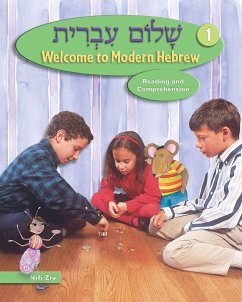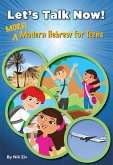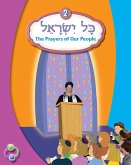Behrman House
Shalom Ivrit Book 1
13,99 €
inkl. MwSt.
Versandfertig in über 4 Wochen

7 °P sammeln
Behrman House
Shalom Ivrit Book 1
- Broschiertes Buch
- Merkliste
- Auf die Merkliste
- Bewerten Bewerten
- Teilen
- Produkt teilen
- Produkterinnerung
- Produkterinnerung
An overview of the authors' research into eurythmy therapy.
Andere Kunden interessierten sich auch für
![Shalom Ivrit Book 2 - Teacher's Edition Shalom Ivrit Book 2 - Teacher's Edition]() Behrman HouseShalom Ivrit Book 2 - Teacher's Edition24,99 €
Behrman HouseShalom Ivrit Book 2 - Teacher's Edition24,99 €![Shalom Ivrit Book 1 - Teacher's Edition Shalom Ivrit Book 1 - Teacher's Edition]() Behrman HouseShalom Ivrit Book 1 - Teacher's Edition24,99 €
Behrman HouseShalom Ivrit Book 1 - Teacher's Edition24,99 €![Shalom Ivrit Book 3 - Teacher's Edition Shalom Ivrit Book 3 - Teacher's Edition]() Behrman HouseShalom Ivrit Book 3 - Teacher's Edition24,99 €
Behrman HouseShalom Ivrit Book 3 - Teacher's Edition24,99 €![Let's Talk Now! More Modern Hebrew for Teens Let's Talk Now! More Modern Hebrew for Teens]() Behrman HouseLet's Talk Now! More Modern Hebrew for Teens13,99 €
Behrman HouseLet's Talk Now! More Modern Hebrew for Teens13,99 €![Shalom, Reader: 57 Hebrew Activities to Show What You Know Shalom, Reader: 57 Hebrew Activities to Show What You Know]() Dina MaibenShalom, Reader: 57 Hebrew Activities to Show What You Know9,49 €
Dina MaibenShalom, Reader: 57 Hebrew Activities to Show What You Know9,49 €![Shalom Uvrachah Funbook Blackline Master Shalom Uvrachah Funbook Blackline Master]() Behrman HouseShalom Uvrachah Funbook Blackline Master26,99 €
Behrman HouseShalom Uvrachah Funbook Blackline Master26,99 €![Kol Yisrael 2 Kol Yisrael 2]() Behrman HouseKol Yisrael 213,99 €
Behrman HouseKol Yisrael 213,99 €-
-
-
An overview of the authors' research into eurythmy therapy.
Hinweis: Dieser Artikel kann nur an eine deutsche Lieferadresse ausgeliefert werden.
Hinweis: Dieser Artikel kann nur an eine deutsche Lieferadresse ausgeliefert werden.
Produktdetails
- Produktdetails
- Verlag: Behrman House Publishing
- Seitenzahl: 128
- Erscheinungstermin: 15. Januar 2003
- Hebräisch
- Abmessung: 256mm x 203mm x 12mm
- Gewicht: 281g
- ISBN-13: 9780874411607
- ISBN-10: 0874411602
- Artikelnr.: 63766780
- Herstellerkennzeichnung
- Libri GmbH
- Europaallee 1
- 36244 Bad Hersfeld
- gpsr@libri.de
- Verlag: Behrman House Publishing
- Seitenzahl: 128
- Erscheinungstermin: 15. Januar 2003
- Hebräisch
- Abmessung: 256mm x 203mm x 12mm
- Gewicht: 281g
- ISBN-13: 9780874411607
- ISBN-10: 0874411602
- Artikelnr.: 63766780
- Herstellerkennzeichnung
- Libri GmbH
- Europaallee 1
- 36244 Bad Hersfeld
- gpsr@libri.de
Hans-Broder von Laue was born in North Germany in 1937. He is a doctor who specialises in anthroposophical medicine. He lectures on cancer treatment and teaches therapeutic eurythmy, and has been widely published. Elke von Laue was born in Dresden, Germany in 1938. She trained as a nurse and has worked as an anthroposophical therapist for many years. She teaches eurythmy therapy and has published several papers on the subject.
1. Introduction 2. The Processes of the Etheric Body Between the Upper and
Lower Human Being 3. The Polar Effects of Consonants and Vowels 25 3.1
Characterization of the polar effects in the Eurythmy Therapy Course 3.2
Summary 3.3 Further characterization giving the opposite point of view 3.4
Description of the polar effects in subsequent literature 3.5 Attempts to
resolve the contradiction 4. The Three Elements of Eurythmy 4.1 Rudolf
Steiner's first description of movement, feeling and character 4.1.1
Perception of movement, feeling and character 4.1.2 Synaesthetic
perceptions of movement, feeling and character 4.1.3 Summary 4.2 Movement,
feeling and character in the Eurythmy Therapy Course 4.3 Other descriptions
of movement, feeling and character 5. Eurythmy Therapy and Other Movement
Therapies 5.1 Physiotherapy (therapeutic gymnastics) 5.2 Dance therapy 5.3
Eurythmy therapy between physiotherapy and dance therapy 6. The Consonants
6.1 A classification of consonants 6.2 A classification of eurythmy therapy
indications for the consonants 6.2.1 Indications for the palate sounds
6.2.2 Indications for the teeth sounds 6.2.3 Indications for the lip sounds
6.2.4 Indications for the middle sounds 6.3 Summary 6.4 The work of blown
and impact sounds in the organism 7. The Vowels 7.1 Rudolf Steiner's
classifications of the vowels 7.2 The relation of speech and eurythmy to
the vowels 7.3 A suggested classification of eurythmy therapy indications
for the vowels 7.3.1 The I and U exercises 7.3.2 The O and E exercises
7.3.3 The A exercise 7.3.4 The Au and Ei exercises 7.4 Summary 8. Vowels
and the Upper Human Being; Consonants and the Lower Human Being 8.1 Sounds
influencing movements 8.2 Sounds acting on the formation of substances with
a specialized function 8.3 Sounds of transformation and individualization
of substances 8.4 Sounds for organ-specific substance creation, the
diphthongs Au and Ei 9. The Soul Exercises 9.1 Exercises with polar
feelings 9.1.1 Forming judgments through thinking: affirming -- negating
9.1.2 Agreement through the will: sympathy -- antipathy 9.2 Polar feeling
exercises and vowel exercises 9.2.1 Love -- E 9.2.2 Hope -- U 9.3 Laughter
-- H-A, Veneration -- A-H 10. Transforming Eurythmy into Eurythmy Therapy
10.1 The connection between moving and speaking or listening 10.2 The
sequence of the eurythmy therapy exercises 10.2.1 The sequence of the vowel
exercises 10.2.2 The swiftness of the consonant exercises 10.2.3 The
sequence of the consonant exercises 10.3 The four steps of transformation
from eurythmy to eurythmy therapy 10.3.1 Arms and legs 10.3.2 Rapid
repetition 10.3.3 Practising and fatigue 10.3.4 Alertness during the
movement 10.3.5 Summary 10.4 Processes of the day and the night to be
activated in the ether body 10.5 Transformation of movement, feeling and
character into eurythmy therapy 10.5.1 Transformation of the movement
element 10.5.2 Transformation of the feeling element 10.5.3 Transformation
of the character element 10.5.4 In which sequence are the elements
experienced? 10.5.5 Summary 11. Harmonizing Speaking and Moving 11.1 When
does the therapist speak and when does the patient move? 11.2 The danger of
speaking while demonstrating eurythmy 12. The of Spatial Relationships 12.1
The direction of eurythmy therapeutic movement 12.2 The location of
movement and of the effect 12.2.1 Migraine -- B 12.2.2 Irregularities in
the abdomen -- M 12.2.3 Ordering the rhythm of breathing and circulation --
R 13. Embryological Formative Gestures and their Reflection in Eurythmy
Therapy 13.1 The spiritual forces of becoming 13.1.1 The formative forces
13.1.2 The secreting forces 13.1.3 The anchoring or consolidation forces
13.2 The transformation of the forces of becoming into living processes
13.3 The three forces as capacities of soul 13.4 Metamorphosis of the three
forces into spiritual capacities 13.5 The three forces and the organism in
eurythmy therapy 14. Examples of Therapeutic Words 14.1 The cancer sequence
O-E-M-L-Ei-B-D 14.2 Chronic constipation, meteorism L-T / D-R 14.3 A child
with hemiplegia S-M-A / L-M-Y / T-M-U 14.4 Teething problems in the upper
jaw L-A and in the lower jaw L-O 14.5 Motor restlessness -- fidgeting
L-U-O-K-M 131 14.6 Dementia R-L-S-I 14.7 Disorder of the liver and
intestine, dysphylaxia, cold feet L I -- M A -- R U 14.8 Hypothyroidism
S-M-I-A 14.9 Hay fever T-S-R-M-A 14.10 Conclusion 15. Future Tasks of
Physicians and Eurythmy Therapists 15.1 Movement diagnosis by the
eurythmist 15.2 Questions from the eurythmy therapist to the physician
15.2.1 Questions about the diagnosis 15.2.2 The patient's life
circumstances and mental state 15.3 Questions from the physician to the
eurythmy therapist 16. Outline of a Physiology of Eurythmy Therapy 17.
Epilogue
Lower Human Being 3. The Polar Effects of Consonants and Vowels 25 3.1
Characterization of the polar effects in the Eurythmy Therapy Course 3.2
Summary 3.3 Further characterization giving the opposite point of view 3.4
Description of the polar effects in subsequent literature 3.5 Attempts to
resolve the contradiction 4. The Three Elements of Eurythmy 4.1 Rudolf
Steiner's first description of movement, feeling and character 4.1.1
Perception of movement, feeling and character 4.1.2 Synaesthetic
perceptions of movement, feeling and character 4.1.3 Summary 4.2 Movement,
feeling and character in the Eurythmy Therapy Course 4.3 Other descriptions
of movement, feeling and character 5. Eurythmy Therapy and Other Movement
Therapies 5.1 Physiotherapy (therapeutic gymnastics) 5.2 Dance therapy 5.3
Eurythmy therapy between physiotherapy and dance therapy 6. The Consonants
6.1 A classification of consonants 6.2 A classification of eurythmy therapy
indications for the consonants 6.2.1 Indications for the palate sounds
6.2.2 Indications for the teeth sounds 6.2.3 Indications for the lip sounds
6.2.4 Indications for the middle sounds 6.3 Summary 6.4 The work of blown
and impact sounds in the organism 7. The Vowels 7.1 Rudolf Steiner's
classifications of the vowels 7.2 The relation of speech and eurythmy to
the vowels 7.3 A suggested classification of eurythmy therapy indications
for the vowels 7.3.1 The I and U exercises 7.3.2 The O and E exercises
7.3.3 The A exercise 7.3.4 The Au and Ei exercises 7.4 Summary 8. Vowels
and the Upper Human Being; Consonants and the Lower Human Being 8.1 Sounds
influencing movements 8.2 Sounds acting on the formation of substances with
a specialized function 8.3 Sounds of transformation and individualization
of substances 8.4 Sounds for organ-specific substance creation, the
diphthongs Au and Ei 9. The Soul Exercises 9.1 Exercises with polar
feelings 9.1.1 Forming judgments through thinking: affirming -- negating
9.1.2 Agreement through the will: sympathy -- antipathy 9.2 Polar feeling
exercises and vowel exercises 9.2.1 Love -- E 9.2.2 Hope -- U 9.3 Laughter
-- H-A, Veneration -- A-H 10. Transforming Eurythmy into Eurythmy Therapy
10.1 The connection between moving and speaking or listening 10.2 The
sequence of the eurythmy therapy exercises 10.2.1 The sequence of the vowel
exercises 10.2.2 The swiftness of the consonant exercises 10.2.3 The
sequence of the consonant exercises 10.3 The four steps of transformation
from eurythmy to eurythmy therapy 10.3.1 Arms and legs 10.3.2 Rapid
repetition 10.3.3 Practising and fatigue 10.3.4 Alertness during the
movement 10.3.5 Summary 10.4 Processes of the day and the night to be
activated in the ether body 10.5 Transformation of movement, feeling and
character into eurythmy therapy 10.5.1 Transformation of the movement
element 10.5.2 Transformation of the feeling element 10.5.3 Transformation
of the character element 10.5.4 In which sequence are the elements
experienced? 10.5.5 Summary 11. Harmonizing Speaking and Moving 11.1 When
does the therapist speak and when does the patient move? 11.2 The danger of
speaking while demonstrating eurythmy 12. The of Spatial Relationships 12.1
The direction of eurythmy therapeutic movement 12.2 The location of
movement and of the effect 12.2.1 Migraine -- B 12.2.2 Irregularities in
the abdomen -- M 12.2.3 Ordering the rhythm of breathing and circulation --
R 13. Embryological Formative Gestures and their Reflection in Eurythmy
Therapy 13.1 The spiritual forces of becoming 13.1.1 The formative forces
13.1.2 The secreting forces 13.1.3 The anchoring or consolidation forces
13.2 The transformation of the forces of becoming into living processes
13.3 The three forces as capacities of soul 13.4 Metamorphosis of the three
forces into spiritual capacities 13.5 The three forces and the organism in
eurythmy therapy 14. Examples of Therapeutic Words 14.1 The cancer sequence
O-E-M-L-Ei-B-D 14.2 Chronic constipation, meteorism L-T / D-R 14.3 A child
with hemiplegia S-M-A / L-M-Y / T-M-U 14.4 Teething problems in the upper
jaw L-A and in the lower jaw L-O 14.5 Motor restlessness -- fidgeting
L-U-O-K-M 131 14.6 Dementia R-L-S-I 14.7 Disorder of the liver and
intestine, dysphylaxia, cold feet L I -- M A -- R U 14.8 Hypothyroidism
S-M-I-A 14.9 Hay fever T-S-R-M-A 14.10 Conclusion 15. Future Tasks of
Physicians and Eurythmy Therapists 15.1 Movement diagnosis by the
eurythmist 15.2 Questions from the eurythmy therapist to the physician
15.2.1 Questions about the diagnosis 15.2.2 The patient's life
circumstances and mental state 15.3 Questions from the physician to the
eurythmy therapist 16. Outline of a Physiology of Eurythmy Therapy 17.
Epilogue
1. Introduction 2. The Processes of the Etheric Body Between the Upper and
Lower Human Being 3. The Polar Effects of Consonants and Vowels 25 3.1
Characterization of the polar effects in the Eurythmy Therapy Course 3.2
Summary 3.3 Further characterization giving the opposite point of view 3.4
Description of the polar effects in subsequent literature 3.5 Attempts to
resolve the contradiction 4. The Three Elements of Eurythmy 4.1 Rudolf
Steiner's first description of movement, feeling and character 4.1.1
Perception of movement, feeling and character 4.1.2 Synaesthetic
perceptions of movement, feeling and character 4.1.3 Summary 4.2 Movement,
feeling and character in the Eurythmy Therapy Course 4.3 Other descriptions
of movement, feeling and character 5. Eurythmy Therapy and Other Movement
Therapies 5.1 Physiotherapy (therapeutic gymnastics) 5.2 Dance therapy 5.3
Eurythmy therapy between physiotherapy and dance therapy 6. The Consonants
6.1 A classification of consonants 6.2 A classification of eurythmy therapy
indications for the consonants 6.2.1 Indications for the palate sounds
6.2.2 Indications for the teeth sounds 6.2.3 Indications for the lip sounds
6.2.4 Indications for the middle sounds 6.3 Summary 6.4 The work of blown
and impact sounds in the organism 7. The Vowels 7.1 Rudolf Steiner's
classifications of the vowels 7.2 The relation of speech and eurythmy to
the vowels 7.3 A suggested classification of eurythmy therapy indications
for the vowels 7.3.1 The I and U exercises 7.3.2 The O and E exercises
7.3.3 The A exercise 7.3.4 The Au and Ei exercises 7.4 Summary 8. Vowels
and the Upper Human Being; Consonants and the Lower Human Being 8.1 Sounds
influencing movements 8.2 Sounds acting on the formation of substances with
a specialized function 8.3 Sounds of transformation and individualization
of substances 8.4 Sounds for organ-specific substance creation, the
diphthongs Au and Ei 9. The Soul Exercises 9.1 Exercises with polar
feelings 9.1.1 Forming judgments through thinking: affirming -- negating
9.1.2 Agreement through the will: sympathy -- antipathy 9.2 Polar feeling
exercises and vowel exercises 9.2.1 Love -- E 9.2.2 Hope -- U 9.3 Laughter
-- H-A, Veneration -- A-H 10. Transforming Eurythmy into Eurythmy Therapy
10.1 The connection between moving and speaking or listening 10.2 The
sequence of the eurythmy therapy exercises 10.2.1 The sequence of the vowel
exercises 10.2.2 The swiftness of the consonant exercises 10.2.3 The
sequence of the consonant exercises 10.3 The four steps of transformation
from eurythmy to eurythmy therapy 10.3.1 Arms and legs 10.3.2 Rapid
repetition 10.3.3 Practising and fatigue 10.3.4 Alertness during the
movement 10.3.5 Summary 10.4 Processes of the day and the night to be
activated in the ether body 10.5 Transformation of movement, feeling and
character into eurythmy therapy 10.5.1 Transformation of the movement
element 10.5.2 Transformation of the feeling element 10.5.3 Transformation
of the character element 10.5.4 In which sequence are the elements
experienced? 10.5.5 Summary 11. Harmonizing Speaking and Moving 11.1 When
does the therapist speak and when does the patient move? 11.2 The danger of
speaking while demonstrating eurythmy 12. The of Spatial Relationships 12.1
The direction of eurythmy therapeutic movement 12.2 The location of
movement and of the effect 12.2.1 Migraine -- B 12.2.2 Irregularities in
the abdomen -- M 12.2.3 Ordering the rhythm of breathing and circulation --
R 13. Embryological Formative Gestures and their Reflection in Eurythmy
Therapy 13.1 The spiritual forces of becoming 13.1.1 The formative forces
13.1.2 The secreting forces 13.1.3 The anchoring or consolidation forces
13.2 The transformation of the forces of becoming into living processes
13.3 The three forces as capacities of soul 13.4 Metamorphosis of the three
forces into spiritual capacities 13.5 The three forces and the organism in
eurythmy therapy 14. Examples of Therapeutic Words 14.1 The cancer sequence
O-E-M-L-Ei-B-D 14.2 Chronic constipation, meteorism L-T / D-R 14.3 A child
with hemiplegia S-M-A / L-M-Y / T-M-U 14.4 Teething problems in the upper
jaw L-A and in the lower jaw L-O 14.5 Motor restlessness -- fidgeting
L-U-O-K-M 131 14.6 Dementia R-L-S-I 14.7 Disorder of the liver and
intestine, dysphylaxia, cold feet L I -- M A -- R U 14.8 Hypothyroidism
S-M-I-A 14.9 Hay fever T-S-R-M-A 14.10 Conclusion 15. Future Tasks of
Physicians and Eurythmy Therapists 15.1 Movement diagnosis by the
eurythmist 15.2 Questions from the eurythmy therapist to the physician
15.2.1 Questions about the diagnosis 15.2.2 The patient's life
circumstances and mental state 15.3 Questions from the physician to the
eurythmy therapist 16. Outline of a Physiology of Eurythmy Therapy 17.
Epilogue
Lower Human Being 3. The Polar Effects of Consonants and Vowels 25 3.1
Characterization of the polar effects in the Eurythmy Therapy Course 3.2
Summary 3.3 Further characterization giving the opposite point of view 3.4
Description of the polar effects in subsequent literature 3.5 Attempts to
resolve the contradiction 4. The Three Elements of Eurythmy 4.1 Rudolf
Steiner's first description of movement, feeling and character 4.1.1
Perception of movement, feeling and character 4.1.2 Synaesthetic
perceptions of movement, feeling and character 4.1.3 Summary 4.2 Movement,
feeling and character in the Eurythmy Therapy Course 4.3 Other descriptions
of movement, feeling and character 5. Eurythmy Therapy and Other Movement
Therapies 5.1 Physiotherapy (therapeutic gymnastics) 5.2 Dance therapy 5.3
Eurythmy therapy between physiotherapy and dance therapy 6. The Consonants
6.1 A classification of consonants 6.2 A classification of eurythmy therapy
indications for the consonants 6.2.1 Indications for the palate sounds
6.2.2 Indications for the teeth sounds 6.2.3 Indications for the lip sounds
6.2.4 Indications for the middle sounds 6.3 Summary 6.4 The work of blown
and impact sounds in the organism 7. The Vowels 7.1 Rudolf Steiner's
classifications of the vowels 7.2 The relation of speech and eurythmy to
the vowels 7.3 A suggested classification of eurythmy therapy indications
for the vowels 7.3.1 The I and U exercises 7.3.2 The O and E exercises
7.3.3 The A exercise 7.3.4 The Au and Ei exercises 7.4 Summary 8. Vowels
and the Upper Human Being; Consonants and the Lower Human Being 8.1 Sounds
influencing movements 8.2 Sounds acting on the formation of substances with
a specialized function 8.3 Sounds of transformation and individualization
of substances 8.4 Sounds for organ-specific substance creation, the
diphthongs Au and Ei 9. The Soul Exercises 9.1 Exercises with polar
feelings 9.1.1 Forming judgments through thinking: affirming -- negating
9.1.2 Agreement through the will: sympathy -- antipathy 9.2 Polar feeling
exercises and vowel exercises 9.2.1 Love -- E 9.2.2 Hope -- U 9.3 Laughter
-- H-A, Veneration -- A-H 10. Transforming Eurythmy into Eurythmy Therapy
10.1 The connection between moving and speaking or listening 10.2 The
sequence of the eurythmy therapy exercises 10.2.1 The sequence of the vowel
exercises 10.2.2 The swiftness of the consonant exercises 10.2.3 The
sequence of the consonant exercises 10.3 The four steps of transformation
from eurythmy to eurythmy therapy 10.3.1 Arms and legs 10.3.2 Rapid
repetition 10.3.3 Practising and fatigue 10.3.4 Alertness during the
movement 10.3.5 Summary 10.4 Processes of the day and the night to be
activated in the ether body 10.5 Transformation of movement, feeling and
character into eurythmy therapy 10.5.1 Transformation of the movement
element 10.5.2 Transformation of the feeling element 10.5.3 Transformation
of the character element 10.5.4 In which sequence are the elements
experienced? 10.5.5 Summary 11. Harmonizing Speaking and Moving 11.1 When
does the therapist speak and when does the patient move? 11.2 The danger of
speaking while demonstrating eurythmy 12. The of Spatial Relationships 12.1
The direction of eurythmy therapeutic movement 12.2 The location of
movement and of the effect 12.2.1 Migraine -- B 12.2.2 Irregularities in
the abdomen -- M 12.2.3 Ordering the rhythm of breathing and circulation --
R 13. Embryological Formative Gestures and their Reflection in Eurythmy
Therapy 13.1 The spiritual forces of becoming 13.1.1 The formative forces
13.1.2 The secreting forces 13.1.3 The anchoring or consolidation forces
13.2 The transformation of the forces of becoming into living processes
13.3 The three forces as capacities of soul 13.4 Metamorphosis of the three
forces into spiritual capacities 13.5 The three forces and the organism in
eurythmy therapy 14. Examples of Therapeutic Words 14.1 The cancer sequence
O-E-M-L-Ei-B-D 14.2 Chronic constipation, meteorism L-T / D-R 14.3 A child
with hemiplegia S-M-A / L-M-Y / T-M-U 14.4 Teething problems in the upper
jaw L-A and in the lower jaw L-O 14.5 Motor restlessness -- fidgeting
L-U-O-K-M 131 14.6 Dementia R-L-S-I 14.7 Disorder of the liver and
intestine, dysphylaxia, cold feet L I -- M A -- R U 14.8 Hypothyroidism
S-M-I-A 14.9 Hay fever T-S-R-M-A 14.10 Conclusion 15. Future Tasks of
Physicians and Eurythmy Therapists 15.1 Movement diagnosis by the
eurythmist 15.2 Questions from the eurythmy therapist to the physician
15.2.1 Questions about the diagnosis 15.2.2 The patient's life
circumstances and mental state 15.3 Questions from the physician to the
eurythmy therapist 16. Outline of a Physiology of Eurythmy Therapy 17.
Epilogue







